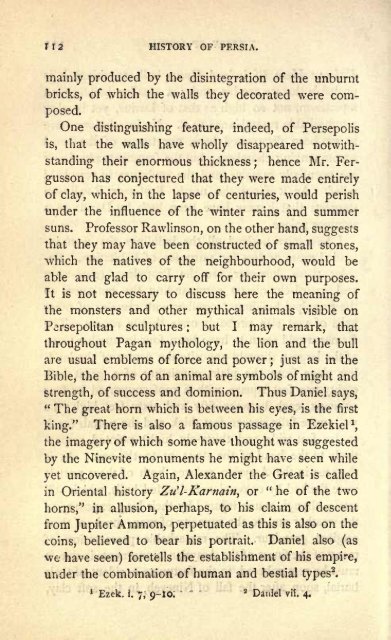Persia from the Earliest Period to the Arab
Persia from the Earliest Period to the Arab
Persia from the Earliest Period to the Arab
Create successful ePaper yourself
Turn your PDF publications into a flip-book with our unique Google optimized e-Paper software.
a HISTORY OF PERSIA.<br />
mainly produced by <strong>the</strong> disintegration of <strong>the</strong> unburnt<br />
bricks, of which <strong>the</strong> walls <strong>the</strong>y decorated were com-<br />
posed.<br />
One distinguishing feature, indeed, of Persepolis<br />
is, that <strong>the</strong> walls have wholly disappeared notwith-<br />
standing <strong>the</strong>ir enormous thickness ; hence Mr. Fer-<br />
gusson has conjectured that <strong>the</strong>y were made entirely<br />
of clay, which, in <strong>the</strong> lapse of centuries, would perish<br />
under <strong>the</strong> influence of <strong>the</strong> winter rains and summer<br />
suns. Professor Rawlinson, on <strong>the</strong> o<strong>the</strong>r hand, suggests<br />
that <strong>the</strong>y may have been constructed of small s<strong>to</strong>nes,<br />
which <strong>the</strong> natives of <strong>the</strong> neighbourhood, would be<br />
able and glad <strong>to</strong> carry off for <strong>the</strong>ir own purposes.<br />
It is not necessary <strong>to</strong> discuss here <strong>the</strong> meaning of<br />
<strong>the</strong> monsters and o<strong>the</strong>r mythical animals visible on<br />
Persepolitan sculptures ; but I may remark, that<br />
throughout Pagan mythology,<br />
<strong>the</strong> lion and <strong>the</strong> bull<br />
are usual emblems of force and power ; just as in <strong>the</strong><br />
Bible, <strong>the</strong> horns of an animal are symbols of might and<br />
strength, of success and dominion. Thus Daniel says,<br />
" The great horn which is between his eyes, is <strong>the</strong> first<br />
king." There is also a famous passage in Ezekiel 1<br />
<strong>the</strong> imagery of which some have thought was suggested<br />
by <strong>the</strong> Ninevite monuments he might have seen while<br />
yet uncovered. Again, Alexander <strong>the</strong> Great is called<br />
in Oriental his<strong>to</strong>ry Zu'l-Karnain, or " he of <strong>the</strong> two<br />
horns," in allusion, perhaps, <strong>to</strong> his claim of descent<br />
<strong>from</strong> Jupiter Ammon, perpetuated as this is also on <strong>the</strong><br />
coins, believed <strong>to</strong> bear his portrait. Daniel also (as<br />
\ve have seen) foretells <strong>the</strong> establishment of his empire,<br />
under <strong>the</strong> combination of human and bestial types 2 .<br />
1 Ezek. f. 7, 9-10.<br />
* Daniel vii. 4.<br />
,

















